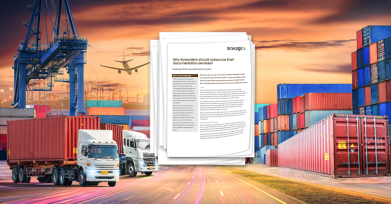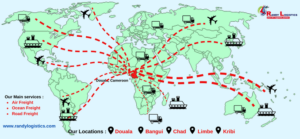International transport documentation
Posted by : Admin

Perhaps the biggest problem for companies involved in international trade is the number of bits of paper which are essential to the performance of their export contracts. That is to say that the documentation involved in the administration of their overseas business is perceived as being abundant in quantity, complex in character and designed to hinder rather than help their export effort.
It is possible to take what is a veritable ‘mountain’ of documents and to rationalize them into four smaller ‘hills’. in that we can categories any document used in international trade into one of four types depending on its origin or application.
The four categories are:
1. Transport;
2. Customs;
3. Insurance;
4. Payment
With a little flexibility all international trade documents can be listed under these headings.
This writeup aims at reviewing one of the major documents in the transport sector often use in international trade known as the BILL OF LADING and its importance in international trade.
THE BILL OF LADING
Shipment of the goods is usually evidenced in a document called a bill of lading. Once a ‘shipped on board’ endorsement has been added (if required), it becomes a receipt for goods shipped on the nominated vessel.
The bill of lading has been defined as a receipt for goods shipped on board a ship, signed by the person (or his agent) who contracts to carry them, and stating the terms on which the goods were delivered to and received by the ship.
The goods are signed for by the vessel’s chief officer or ship’s agent. If the cargo is in good condition and everything is in order, no endorsement will be made on the document, and it can be termed a clean bill of lading. Conversely, if the goods are damaged or a portion of the consignment is missing, the document will be suitably endorsed by the Master or his agent, and the bill of lading will be considered ‘claused’ or ‘unclean’.
PROCEDURE
1. The exporter, or their agent, completes an Export Cargo Shipping
Instruction (ECSI) from which the Bills will be produced from the shipping line’s computers.
2. The goods are delivered into the port or depot with a Shipping Note.
3. Goods are recorded, compared with the Stowage Plan and Booking References, and entered on to the Ship’s Manifest.
4. Once the goods are in the possession of the carrier, the Bills of Lading are produced behalf of the Ship’s Master and returned to the exporter/agent. Computer produced Bills may carry facsimile signatures, but are still issued on behalf of the Ship’s Master.
Whilst the layout of Bills differs from one carrier to another, the majority are now produced with very similar A4 size layouts and contain broadly the same information.
AT ORIGIN
The goods are signed for by the vessel’s chief officer or ship’s agent. If the cargo is in good condition and everything is in order, no endorsement will be made on the document, and it can be termed a clean bill of lading. Conversely, if the goods are damaged or a portion of the consignment is missing, the document will be suitably endorsed by the Master or his agent, and the bill of lading will be considered ‘claused’ or ‘unclean’.
AT DESTINATION
The shipowner or his agent at the port of destination will require one original bill of lading to be presented to him before the goods are handed over. Furthermore, he will normally require payment of any freight due, should this not have been paid at the port of shipment. When one of a set of bills of lading has been presented to the shipping company, the other bills in the set lose their value. In the event of the bill of lading being lost or delayed in transit, the shipping company will allow delivery of the goods to the person claiming to be the consignee, if he gives a letter of indemnity; this is normally countersigned Bills of lading by a bank, and relieves the shipping company of any liability should another person eventually come along with the actual bill of lading.
FUNCTIONS
The Bill of Lading has three major functions:
1. A receipt for the goods.
2. Evidence of the Contract of Carriage.
3. A Document of Title
TYPES OF BILLS OF LADING
There are several types and forms of bills of lading and in the case of combined or multi-modal transport they are called transport documents.
Some types include:
CONTENT OF THE BILL OF LADING
Given below are the clauses found in a bill of lading which may be used as Port to Port, or Combined Transport, or a mix, Port to Port at one end with Combined Transport at the other.
Shipper, Consignee or order, Notify party/address, Vessel and voyage number/Port of loading/port of discharge, Place of receipt/Place of delivery, Undermentioned particulars as declared by the shipper but not acknowledged by the carrier, Total number or containers/packages received by the carrier, Freight payable at, Incorporation clause, Number of original Bills of Lading, Place and date of issue, etc.
A growth sector of the containerized market is the movement of compatible consignments from individual consignors to various consignees usually situated in the same destination (country/area) and forwarded as one overall consignment. RANDY LOGISTISTICS partners with major shipping lines such as: MAERSK, CMA-CGM, MSC, HAPAG LLOYD in consolidation of goods into full container loads from different shippers heading to the same destination and issues a house bill of lading to the owners. We issue a house bill of lading cross referring to the ocean bill of lading to be presented at destination by the shipper against the receipt of the goods. It is merely a receipt for the cargo and does not have the same status as the bill of lading issued by the shipowner. Advantages of groupage include: less packing; lower insurance premiums; usually quicker transits; less risk of damage and pilferage; and lower rates when compared with such cargo being dispatched as an individual parcel/consignment.
For all your international transport of goods by sea, to CAMEROON, BANGUI and CHAD, remember to inscribe RANDY LOGISTICS on your bill of lading as the consignee and notify party, as sure we shall provide you with competitive rates and excellent services.
